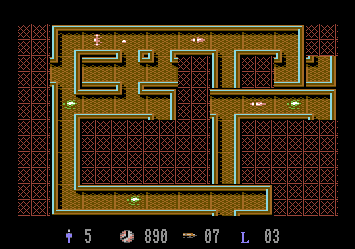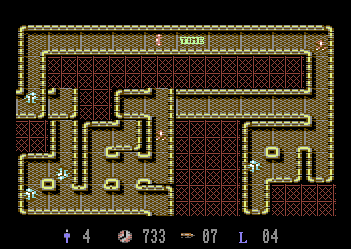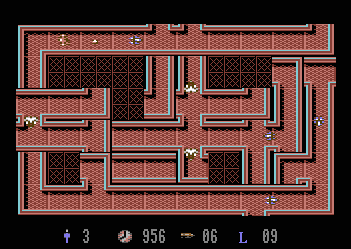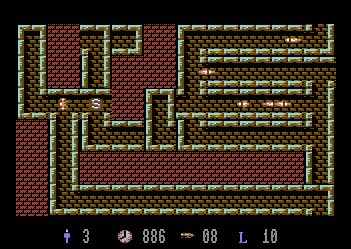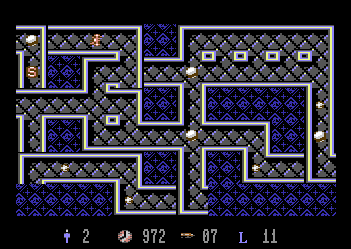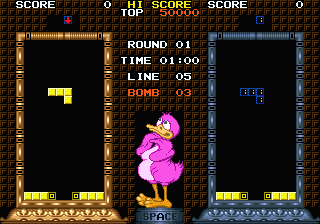INTERCHANGE
Don't overlook this Commodore 64 gem
Oh, good. It's you. There's a C64 game that I've been looking forward to showing you. If anyone will understand why it's awesome, you will. You've never heard or read about it; as usual, that makes no difference. It's a hell of a lot of fun. Here -- take the controller. It's not difficult to start playing right away. I'll be explaining everything that isn't immediately clear.
It's called Interchange. That's what appears on the title screen, and I always go with the intentions of the programmer(s). Pal Developments, the company that came up with the Sinclair ZX Spectrum original, licensed it to Hi Tec Software, which released it in 1991 and added CPC Amstrad and Commodore 64 versions. An Amiga adaptation followed.
The folks at Hi Tec weren't quite high-tech enough to spell their own business's name correctly or use a hyphen, and this gives us some indication of their collective intelligence. They evidently felt that the title Interchange wasn't cutesy enough. Well, of course it wasn't! If you're into video games, you're obviously five years old. This was, after all, the era of infantile Japanese characters, which were mainly Nintendo's fault.
They renamed it Insector Hecti in the Inter Change, exhibiting admirable resolve in their abiding anti-hyphen stance. (Maybe they simply didn't have the budget for punctuation.) The childish, condescending packaging must have horrified the game's actual creators. The winged character in the illustration is so corny that I'm not even going to acknowledge the flagrant revisionism by making you look at him. You're welcome.
Hi Tec hired a group called Digital Design to create the C64 version. Nick Taylor, Dave Saunders and Ashley Routledge did such a phenomenal job that they happened to utterly bury all other renditions, save for the nearly identical Amiga game, which didn't exist yet anyway.
As you can see, your character (near the top center) is plainly not a giant insect. There aren't even any metaphorical bugs in the game; it's smooth, solid and responsive. You're in control of an armed, armored warrior / construction worker (one presumes) who's viewed from the top down. He navigates maze after unique maze, hoping to locate and fix every man-sized section that's not aligned properly. The objective is to create an uninterrupted route around the screen.
Pushing the fire button while standing still rotates the currently occupied corner or straight section ninety degrees. The sound of a bell tells you when it's finally correct. Every position except the odd four-way junction can be swiveled, so if you don't choose a spot that's wrong to begin with, you'll find yourself pushing the button four times before you hear the chime (or just twice, if the present length of corridor can only be horizontal or vertical).
During movement, the fire button actually fires. This is fortunate, as the mazes are inhabited by robotic vehicles that will run right over your counterpart, apparently without even noticing. Some of them look like beetles; maybe that's where Hi Tec got the insect idea from. It's still wrong, mind you. Some of the later robots resemble snowballs, but you wouldn't consider renaming the game Jack Frost in the Winterchange.
A vaguely related thought: Guided snowballs would be awesome.
Anyway, the game begins with the request, "ENTER NAME:". I'm not sure what good this does, but after entering the word "NAME" -- possibly just to pass a simple cognition test that's meant to verify your ability to handle the game itself -- you're briefly shown the first level without incongruities. Then the pertinent sections flip into their wrong positions, the robots materialize and off you go. Every level begins this way; but as the amount of muddled bits increases, it's harder to spot them all during this fleeting sneak-peek. They're usually easy to differentiate from the correct parts during game-play anyway, albeit with likewise lessening frequency as the mazes grow more intricate, the continuous overall paths tougher to eyeball. You'll often see a misalignment that can't be reached until another has been righted that's visually nearby, but accessible only via the long way around.
I'm intrigued whenever I chance upon a game that manages to combine action and puzzle elements without weakening either type, and whenever I encounter conventions that I usually can't stand, but whose game turns out to be so enjoyable that my peeves are superseded.
One thing that will kill a game for me before I've even given it a chance is a time limit. I prefer the freedom to explore all of the surroundings, nuances, possible strategies, etc. This clock is extremely generous, however, starting at 999 as each level begins and descending very slowly. I've never run out of time, even while scrutinizing a maze for the last couple of flaws. Rather than posing a genuine threat, the timer serves as a means of goading the player to make headway. It lends an extra sense of significance to his actions, a further feeling of triumph to each level completion -- as in, say, the occasional '80s Activision game.
Another element that I tend to find objectionable is limited ammunition. Seldom is there a justifiable reason for that fun-damaging irritant; but here, it's a successfully integrated bit of the game's puzzley side. Each labyrinth contains a finite number of robots and no imminent reinforcements, so you get to decide which to dispose of in the easy, just-gun-'em-down way -- your bouncy projectiles will turn to follow corridors until they meet targets or breaks -- and which to destroy with the walls.
That alternative attack is one of the coolest, most novel things about this already original game. If your timing is good (you're thankfully given some leeway), you can swivel a wall right into a robot, instantly making it an ex-robot.
What's more, power-ups often appear, their locations and effects random. If you reach one before it vanishes, it adds time to the clock or momentarily stops it; briefly freezes or immediately destroys all extant robots; temporarily speeds up your character's movement; gives him more ammo; or surrounds him with an ephemeral, robot-wrecking shield.
The S seen here is the shield power-up. I probably didn't need to point that out. You wouldn't have assumed that it stood for "shark." There's a noticeable absence of water.
I've actually mentioned that for an additional reason. Somebody clearly goes to the trouble of mopping each maze before you arrive, so he must be drying it as well. Notice how vivid and shiny everything is. None of those grimy, smudgy graphics in this game! No matter how long you own it, it will always look like you've just brought it home from the store.
The robots don't seek you out; they're just making the rounds. You're only in danger when you happen to get in the way, either due to cockiness or mistiming. The latter is increasingly likely as the robots grow in number, because your firing rate is the familiar one-at-a-time. One would think that they'd be protecting you, though. You're helping them out by creating this nice walkway so they never have to turn around.
A non-arcane, perfectly comprehensible password is provided after every fifth level, so you can easily begin subsequent games past the simpler, get-used-to-stuff mazes. You're given five men, no extras and, refreshingly, no score. You reach a certain level from the one you've started on, and that's it, apart from potentially beating some of the record times stored on the disk.
The difficulty progression is agreeably gradual, and it's executed in all the right ways, building on the intrinsic game-play itself instead of relying on deceit (memorization-dependent traps, for instance) or big, bossy bad guys that are contrived out of nothing and intermittently forced into the existing paradigm. The initial elements are simply made ever trickier.
The massive amount of structural variety between mazes keeps the game continually fresh and engrossing. Even the color schemes are diverse, keeping fatigue from the eye. Merely superficial as they are, inspired graphical trimmings abound, such as the surreal terrain behind each maze that scrolls endlessly and changes direction to inversely reflect controller movement.
This leads me to point out a further hazard, another that afflicts only the cocky player: gravity. Careless movement near the occasional skewed section puts you in danger of wandering right off the edge of the whole damn game. It looks very funny when that happens, actually.
As usual with my favorite games -- even if "my favorite games" have come to number approximately 91474658346154106502392680650756012741002 -- all of the apparently minor details add up to a major visceral and aesthetic success. It's non-passive art like this that heightens the overall quality of life. Interchange embodies an original, imaginative, simply great idea, which is implemented well: the eternally sought combination. When there's room for enemy snowballs, even better.
What's that? Well, of course you can threaten them as you would any other adversary! In fact, here's the first item on a list that I'm just now making up of the Worst Tough-Guy Lines Ever Uttered: "I'm gonna carve my initials in ya!"
That could even be a great non-video game: Come up with wonderfully bad action-movie / game lines. "I'm gonna help ya across the street!" I'm well aware that I've wandered from the subject, but really, fun is fun. "Ya better watch it, or I'll renew yer library card!" It could easily apply to the game above: "I got yer interchange for a dollar right here!" Not bad, but I can do better. Hmm. "Yer gonna have ta interchange yer shorts when I'm done with ya!"
Now, if only I could figure out why the on-screen text keeps referring to me as "NAME."
BONUS GAME:
MOSAIC
A 1990 coin-op by some company called Space
If you're like me, you've often thought, "I like Tetris, but it's missing something. If only it had a giant, purple duck." Well, our wish has been granted!
I'm not convinced that "Space" is actually the name of the company. It's more likely that someone misunderstood the sign in the window after the business closed.
